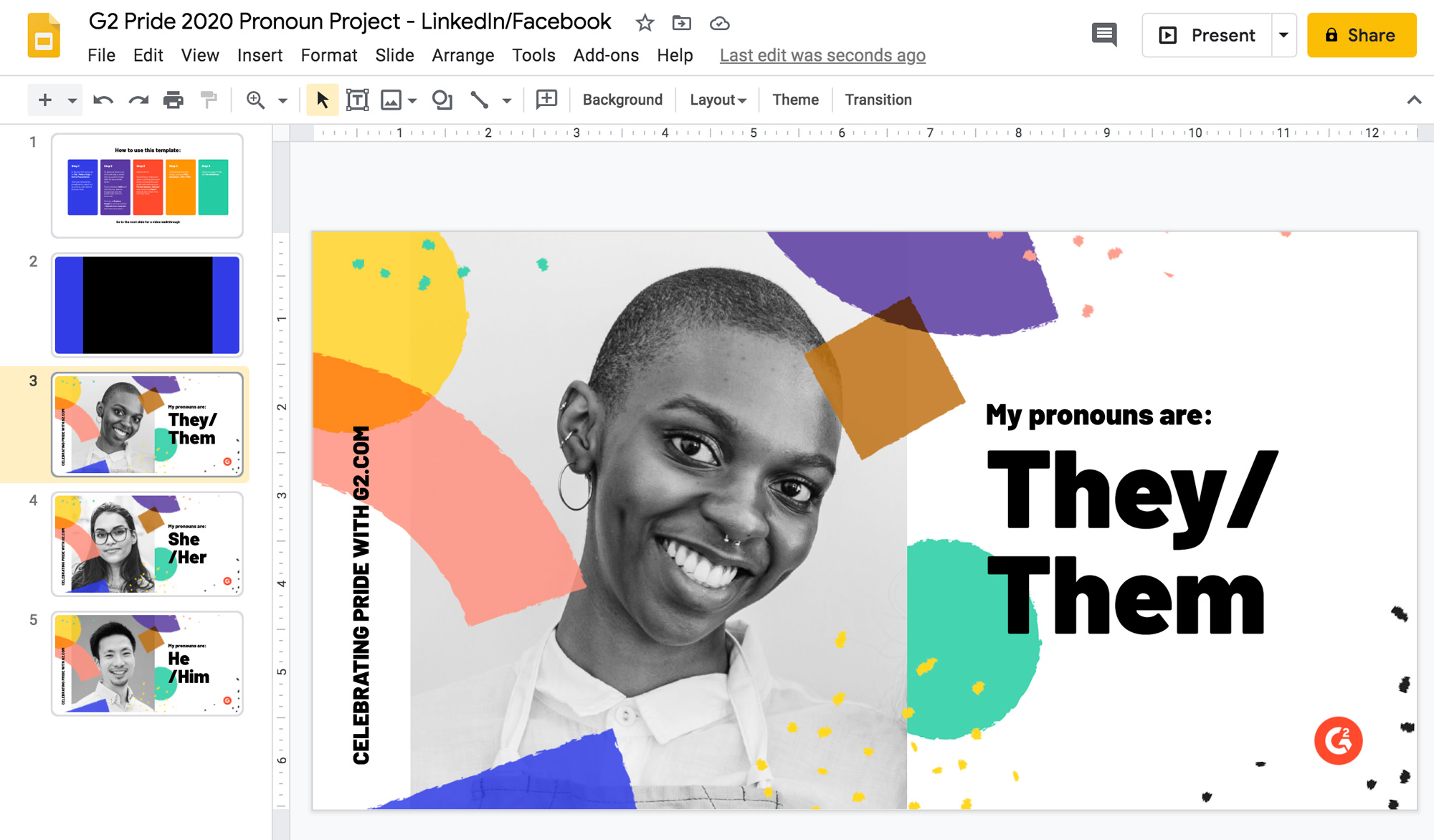Earlier this year, my company, G2, launched an initiative for Pride Month called the G2 Pronoun Project. We offered a badge for anyone to download declaring what pronouns they choose to go by. In addition to sharing it across our company, we also made it available externally. For several months, I made a link to this initiative a standard part of my email signature. For me, this is a fairly big move — I take email signatures seriously and even once wrote an article about why these signatures can make important statements.
I’ve been struck by the responses we’ve received to this project and the responses I’ve personally received to my pronoun messaging. Most people have supported the idea — many of them even effusively, including people who, like me, identify by cisgender pronouns (in my case, he/him). But they’ve also seen it as a sign of something much larger than gender. They’ve viewed it as a sign of commitment to respecting everyone’s individuality.

To show respect for individuality, G2 offered downloadable templates for employees to use to assert their personal pronoun preference.
As the United States, and much of the world, reckons with racism, sexism, and other forms of intolerance in society and the workplace, what can sometimes get lost is a focus on individuality. As Paula Glover and Katie Mehnert wrote in a recent article on fixing systemic issues in organizations, “Even well-meaning people expect individuals to speak for entire groups of people. … In encouraging employees to have their own conversations with people of different backgrounds, executives and senior managers should emphasize individuality.”
This is a challenge that leaders who are committed to achieving diversity and inclusion have faced for decades. In their 1995 book Diversity in Organizations, Martin M. Chemers, Stuart Oskamp, and Mark A. Costanzo noted that diversity in organizations generally refers to “socially meaningful categorizations” but that “many people view their individuality and uniqueness as a significant part of themselves that they would not like to be overlooked.”
When it comes to identifying personal pronouns, it’s up to each individual to decide for themselves what to go by. (Even the use of “themselves” instead of “him- or herself” in the previous sentence is, to some, a sign of changing times, as Merriam-Webster has noted.) No one can look at you and tell you what pronouns you choose to use. At G2, we decided to embrace this individuality through this project, since everyone has a gender identity.
It also helps destigmatize those who may identify by less common pronouns. The LGBTQIA Resource Center at the University of California, Davis, recommends, “Make a habit of introducing yourself with your pronouns, not just in LGBTQIA-specific situations. This makes sharing pronouns routine, instead of singling out certain people or communities.”
Some business leaders may be wary of expressing openness to individually chosen pronouns out of fear of alienating people, including potential customers, who may be more socially conservative. But I’m a marketer obsessed with building relationships with as many people as possible, and I’ve found that rather than losing prospects, the practice of openly supporting people in choosing their own pronouns has built an even wider audience. And as Dipanjan Chatterjee and Nick Monroe have written, in order to appeal to younger demographics, brands need to recognize that marketing “beyond the gender binary” is critical for staying relevant in the years ahead.
Encouraging Mental Wellness
There’s also another reason why supporting individuals’ choices for pronouns is so important: Doing so can help improve mental health.
Studies have looked at the mental health of people who identify as part of a gender minority, a term the Centers for Disease Control and Prevention defines as “individuals whose gender identity (man, women, other) or expression (masculine, feminine, other) is different from their sex (male, female) assigned at birth.” People who fit into this category are more likely to experience depression, anxiety, and suicidal behavior.
Social support, in which the individual’s gender identity is accepted without stigma, can be very helpful. “Using a person’s preferred pronouns demonstrates respect and also provides a safe and inclusive environment,” New York City-based Flatiron Mental Health Counseling explains.
I’ve spoken and written about my own mental health journey, including my experiences with anxiety and depression. I’ve found that rather than stigmatizing me for it, colleagues in my company and in my broader professional community have been supportive. I want everyone to feel free to talk about their own experiences as well, and to have the same support I did.
There’s also a dollars-and-cents reason for businesses to do this. “Workplaces that promote mental health … are more likely to reduce absenteeism, increase productivity, and benefit from associated economic gains,” according to the World Health Organization.
The best workplace cultures also go a long way in attracting and retaining the best employees. At G2, one of our core values is kindness. Employees have said they see the G2 Pronoun Project as a reflection of that value.
There’s no doubt that the end of an era in which everyone had to identify as “he” or “she” will take some getting used to, and some people may remain resistant to the change. But cisgender people can help move it along by making pronoun declarations ubiquitous. That’s why I currently have mine on both my LinkedIn and Instagram accounts. I encourage leaders to put thought into how they can model similar behavior and start using personal pronouns more visibly themselves. It requires being open to new conversations, but the payoff for encouraging individuality and supporting inclusivity cannot be overestimated.
Why Pronouns Speak To More Than Just Gender Differences
No comments:
Post a Comment